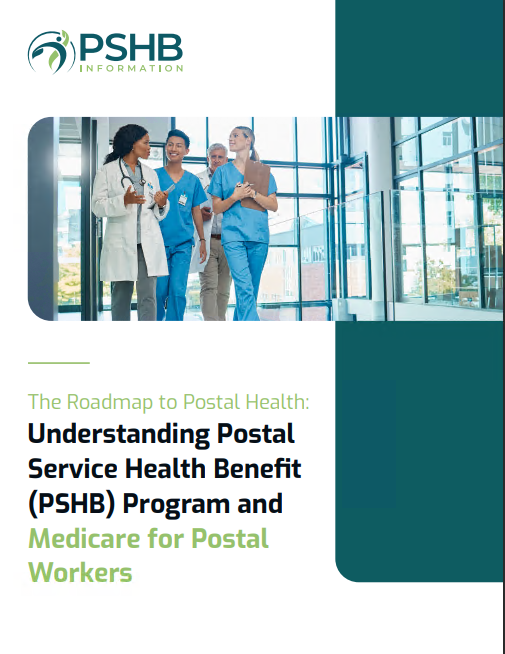Key Takeaways
-
Medicare Part C, or Medicare Advantage, can complement your Postal Service Health Benefits (PSHB) coverage by offering additional services and flexibility that cater to retirees’ diverse needs.
-
Understanding how Medicare Part C integrates with PSHB can help you make more informed decisions about your healthcare coverage and reduce out-of-pocket expenses.
The Basics of Medicare Part C
Medicare Part C, commonly known as Medicare Advantage, is an alternative to Original Medicare that allows you to receive your Medicare Part A (hospital) and Part B (medical) benefits through private insurance plans. These plans often include additional services like prescription drug coverage (Part D), dental, vision, and wellness programs.
If you’re a Postal Service retiree or nearing retirement, Medicare Advantage offers a unique way to enhance your existing PSHB benefits, providing both comprehensive coverage and flexibility. But before diving into how it works with PSHB, let’s cover the basics of Medicare Part C.
-
Eligibility: To enroll in Medicare Part C, you must be enrolled in Medicare Parts A and B.
-
Enrollment Periods: Key enrollment windows include your Initial Enrollment Period (IEP) around your 65th birthday, the Annual Enrollment Period (AEP) from October 15 to December 7, and Special Enrollment Periods (SEP) triggered by qualifying life events.
-
Plan Structure: Medicare Advantage plans typically include networks of doctors and hospitals, and you may need referrals for specialist visits depending on the plan type.
How PSHB and Medicare Work Together
The Postal Service Health Benefits (PSHB) program is tailored for postal workers and retirees, offering a range of health plans with comprehensive coverage. As a retiree, coordinating your PSHB plan with Medicare, particularly Medicare Part C, can provide significant benefits. Here’s how:
-
Primary and Secondary Coverage:
-
When you’re enrolled in Medicare Part B, Medicare generally becomes your primary coverage, while PSHB acts as secondary coverage to fill gaps such as deductibles and copayments.
-
Medicare Advantage plans take this coordination a step further by bundling services, offering cost-saving opportunities.
-
-
Prescription Drug Coverage:
-
Many Medicare Advantage plans include Part D prescription drug coverage, which can supplement or replace PSHB’s drug benefits. This integration can reduce out-of-pocket medication costs.
-
-
Additional Benefits:
-
Medicare Advantage often includes benefits not traditionally covered by PSHB, such as fitness programs, telehealth, and certain preventive services, giving you more value for your premiums.
-
Why Consider Medicare Part C as a Retiree?
Medicare Advantage plans are designed to cater to diverse healthcare needs, making them an attractive option for retirees looking to expand their coverage. Here are some reasons why Medicare Part C could be a good fit for you:
Comprehensive Coverage Options
Unlike Original Medicare, which has limitations on services like vision or dental, many Medicare Advantage plans include these extras. For PSHB enrollees, this means you can enjoy a broader range of healthcare services while keeping your out-of-pocket costs predictable.
Simplified Billing
With Medicare Advantage, you receive all your Medicare-covered services through one plan. This simplifies billing and paperwork compared to juggling separate Part A, Part B, and PSHB claims.
Cost Management
Medicare Advantage plans have annual out-of-pocket maximums, which can provide financial protection against high medical expenses. Combined with your PSHB benefits, this can lead to substantial savings over time.
Enrollment Timelines and Coordination Tips
To make the most of Medicare Part C alongside your PSHB benefits, understanding enrollment timelines and coordination tips is crucial.
Key Enrollment Periods
-
Initial Enrollment Period (IEP): This seven-month window begins three months before your 65th birthday, includes your birth month, and ends three months after.
-
Annual Enrollment Period (AEP): Held from October 15 to December 7 each year, this is your opportunity to switch to or enroll in a Medicare Advantage plan.
-
Medicare Advantage Open Enrollment Period: From January 1 to March 31, you can switch Medicare Advantage plans or return to Original Medicare.
Tips for Smooth Coordination
-
Assess Your Needs:
-
Review your current PSHB plan to identify coverage gaps Medicare Advantage could fill. Think about services like dental, vision, or prescription drugs.
-
-
Compare Plans:
-
Use online tools or consult a licensed professional to compare Medicare Advantage plans. Pay attention to network restrictions and extra benefits.
-
-
Inform Your Providers:
-
Ensure your healthcare providers accept Medicare Advantage plans to avoid unexpected costs.
-
-
Stay Informed:
-
Keep an eye on the Annual Notice of Change (ANOC) from your Medicare Advantage plan to stay updated on coverage changes.
-
Enhancing Your PSHB Coverage with Medicare Part C
When Medicare Advantage is combined with PSHB, you can unlock benefits that neither program offers individually. Here’s how this dynamic partnership can work in your favor:
Filling Coverage Gaps
PSHB plans are comprehensive, but they may have limitations on services like hearing aids or specialized therapies. Medicare Advantage can step in to provide these additional benefits, ensuring you receive the care you need without breaking the bank.
Streamlining Care Coordination
Medicare Advantage plans often include care coordination services, which help manage chronic conditions, schedule preventive services, and coordinate between specialists. This can lead to better health outcomes and less stress for retirees managing multiple providers.
Reducing Out-of-Pocket Costs
By integrating Medicare Advantage with PSHB, you can take advantage of lower premiums, copayments, and deductibles. Many Medicare Advantage plans also offer capped out-of-pocket expenses, adding an extra layer of financial security.
Common Misconceptions About Medicare Advantage
Despite its benefits, Medicare Part C is sometimes misunderstood. Let’s address some common misconceptions:
-
“Medicare Advantage Replaces PSHB”:
-
False. Medicare Advantage works alongside PSHB, not as a replacement. You retain your PSHB benefits while adding the flexibility and extras offered by Part C.
-
-
“You Lose Access to Providers”:
-
Not necessarily. While some plans have network restrictions, others offer broader access. It’s important to choose a plan that fits your healthcare preferences.
-
-
“Medicare Advantage is Too Complicated”:
-
With proper guidance and research, Medicare Advantage can be easy to navigate. Most plans simplify billing and provide customer support to answer your questions.
-
What to Watch Out For
While Medicare Advantage can enhance your PSHB coverage, it’s essential to consider potential challenges:
-
Network Limitations:
-
Some Medicare Advantage plans require you to use specific providers or hospitals. Ensure your preferred doctors are in-network before enrolling.
-
-
Plan Changes:
-
Medicare Advantage plans can change annually. Review your plan’s coverage and costs each year during Open Enrollment.
-
-
Coordination Issues:
-
Properly coordinating Medicare Advantage and PSHB benefits may require some effort. Work with your plan’s customer service to understand how benefits align.
-
Choosing the Right Coverage for Your Needs
Every retiree has unique healthcare needs, so there’s no one-size-fits-all solution. To make the best decision:
-
Evaluate Your Health Needs:
-
Consider factors like your prescription drug usage, frequency of doctor visits, and any chronic conditions.
-
-
Compare Costs:
-
Look beyond premiums to consider deductibles, copayments, and out-of-pocket maximums.
-
-
Seek Guidance:
-
If you’re unsure about your options, consult a Medicare advisor or attend informational sessions offered by your PSHB program.
-
Making Medicare Part C Work for You
Medicare Part C can be a valuable addition to your PSHB benefits, offering enhanced coverage, reduced costs, and added flexibility. By understanding how the two programs interact and carefully evaluating your options, you can create a comprehensive healthcare plan that meets your needs in retirement.








